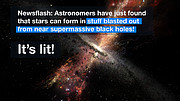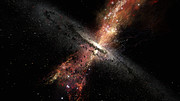Scientists have discovered a mysterious flash of X-rays using NASA's Chandra X-ray Observatory, in the deepest X-ray image ever obtained, as reported in our latest press release. The X-ray source is located in a region of the sky known as the Chandra Deep Field-South (CDF-S), which is shown in the main panel of this graphic. Over the 17 years Chandra has been operating, the telescope has observed this field many times, resulting in a total exposure time of 7 million seconds, equal to two and a half months. In this CDF-S image, the colors represent different bands of X-ray energy, where red, green, and blue show the low, medium, and high-energy X-rays that Chandra can detect.
The mysterious source that scientists discovered, shown in the inset
box, has remarkable properties.
Prior to October 2014, this source was
not detected in X-rays, but then it erupted and became at least a factor
of 1,000 brighter in a few hours. After about a day, the source had
faded completely below the sensitivity of Chandra.
Thousands of hours of legacy data from the Hubble and Spitzer Space
Telescopes helped determine that the event came from a faint, small
galaxy about 10.7 billion light years from Earth. For a few minutes, the
X-ray source produced a thousand times more energy than all the stars
in this galaxy.
While scientists think this source likely comes from some sort of
destructive event, its properties do not match any known phenomenon.
This means this source may be of a variety that scientists have never
seen before.
The researchers do, however, have some ideas of what this source
could be. Two of the three main possibilities to explain the X-ray
source invoke gamma-ray burst (GRB)
events, which are jetted explosions triggered either by the collapse of
a massive star or by the merger of a neutron star with another neutron star or a black hole.
If the jet is pointing towards the Earth, a burst of gamma-rays is
detected. As the jet expands, it loses energy and produces weaker, more
isotropic radiation at X-ray and other wavelengths.
Possible explanations for the CDF-S X-ray source, according to the
researchers, are a GRB that is not pointed toward Earth, or a GRB that
lies beyond the small galaxy. A third possibility is that a medium-sized
black hole shredded a white dwarf star.
Thousands of hours of legacy data from the Hubble and Spitzer Space
Telescopes helped determine that the event came from a faint, small
galaxy about 10.7 billion light years from Earth. For a few minutes, the X-ray source produced a thousand times more energy than all the stars in this galaxy.
The mysterious X-ray source was not seen at any other time during the
two and a half months of exposure time Chandra has observed the CDF-S
region. Moreover, no similar events have yet been found in Chandra
observations of other parts of the sky.
This X-ray source in the CDF-S has different properties from the as
yet unexplained variable X-ray sources discovered in the elliptical
galaxies NGC 5128 and NGC 4636
by Jimmy Irwin and collaborators. In particular, the CDF-S source is
likely associated with the complete destruction of a neutron star or
white dwarf, and is roughly 100,000 times more luminous in X-rays. It is
also located in a much smaller and younger host galaxy, and is only
detected during a single, several-hour burst.
Additional highly targeted searches through the Chandra archive and
those of ESA's XMM-Newton and NASA's Swift satellite may uncover more
examples of this type of variable object that have until now gone
unnoticed. Future X-ray observations by Chandra and other X-ray
telescopes may also reveal the same phenomenon from other objects.
A paper describing this result appears in the June 2017 issue of the Monthly Notices of the Royal Astronomical Society and is available online.
NASA's Marshall Space Flight Center in Huntsville, Alabama, manages the
Chandra program for NASA's Science Mission Directorate in Washington.
The Smithsonian Astrophysical Observatory in Cambridge, Massachusetts,
controls Chandra's science and flight operations.
Fast Facts for CDF-S Transient:
Scale: Main Image is 16 arcmin across; Inset Image is 3.7 arcsec across
Category: Cosmology/Deep Fields/X-ray Background, Black Holes
Coordinates (J2000): RA 03h 32m 39s | Dec -27° 51' 34"
Constellation: Fornax
Observation Date: Inset Image: October 2, 2014
Observation Time: Inset Image: 26 hours 7 minutes.
Obs. ID: Inset Image: 16454
Instrument: ACIS
References: Bauer, F. et al., 2017, MNRAS (in press); arXiv:1702.04422
Color Code: Inset Image: X-ray (Blue)
Distance Estimate: About 10.7 billion light years
Source: NASA’s Chandra X-ray Observatory














